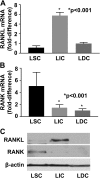RANKL/RANK Pathway and Its Inhibitor RANK-Fc in Uterine Leiomyoma Growth
- PMID: 29741640
- PMCID: PMC6276708
- DOI: 10.1210/jc.2017-01585
RANKL/RANK Pathway and Its Inhibitor RANK-Fc in Uterine Leiomyoma Growth
Abstract
Context: Uterine leiomyomas are the most common type of gynecologic tumor in women.
Objective: To determine the role of the cytokine receptor activator of nuclear factor κ-Β ligand (RANKL); its receptor, receptor activator of nuclear factor κ-Β (RANK); and the RANKL/RANK pathway inhibitor RANK-Fc in leiomyoma growth.
Design: Messenger RNA (mRNA) or protein levels of RANKL, RANK, and proliferation markers cyclin D1 and Ki67 were assessed in various leiomyoma tissues and cell populations. Human xenograft experiments were performed to determine the effects of RANK-Fc on leiomyoma growth in vivo.
Setting: Research laboratory.
Patients: Twenty-four regularly cycling premenopausal women (age 28 to 49 years) who were not receiving hormone therapy.
Interventions: None.
Main outcome measure: Tumor growth in a murine xenograft model following targeting of the RANKL/RANK pathway with RANK-Fc.
Results: RANKL mRNA levels in leiomyoma were significantly higher than those in myometrial tissues. The highest RANK levels were found in the leiomyoma stem cell population, which is deficient in progesterone receptor (PR). Conversely, the highest RANKL levels were found in the PR-rich leiomyoma intermediate cell (LIC) population. R5020, a PR agonist, specifically increased RANKL expression in LICs. RANK-Fc blocked RANKL-induced expression of the proliferative gene cyclin D1. Treatment with RANK-Fc also significantly decreased tumor growth in vivo and diminished the expression of proliferation marker Ki67 in tumors (P < 0.01; n = 4).
Conclusions: Treatment with the RANKL/RANK pathway inhibitor RANK-Fc significantly decreased human leiomyoma cell proliferation and tumor growth. This suggests that the RANKL/RANK pathway could serve as a potential target for the prevention and treatment of uterine leiomyoma.
Figures





References
-
- Baird DD, Dunson DB, Hill MC, Cousins D, Schectman JM. High cumulative incidence of uterine leiomyoma in black and white women: ultrasound evidence. Am J Obstet Gynecol. 2003;188(1):100–107. - PubMed
-
- American College of Obstetricians and Gynecologists ACOG practice bulletin. Alternatives to hysterectomy in the management of leiomyomas. Obstet Gynecol. 2008;112(2 Pt 1):387–400. - PubMed
-
- Bulun SE. Uterine fibroids. N Engl J Med. 2013;369(14):1344–1355. - PubMed
Publication types
MeSH terms
Substances
Grants and funding
LinkOut - more resources
Full Text Sources
Other Literature Sources
Medical
Research Materials

